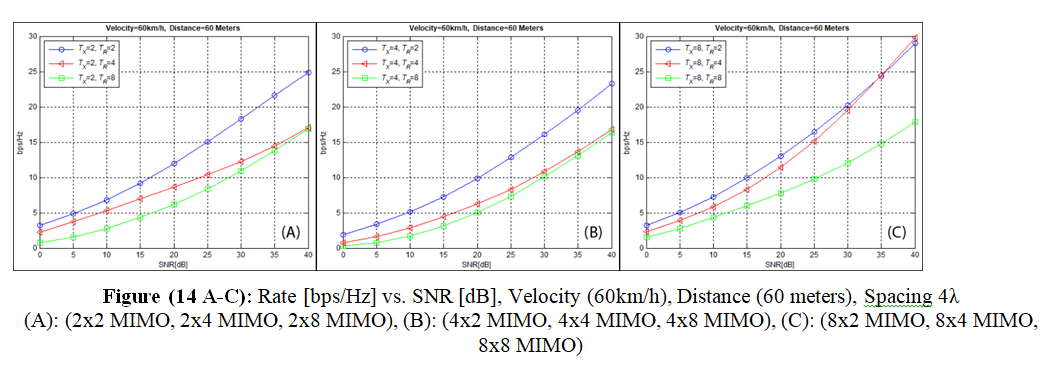Validating the Channel Capacity in V2V Communication based on SCME Channel Model with Turbo-BLAST Coding
DOI:
https://doi.org/10.71229/njemcs.v1i1.3Keywords:
CDF, , Channel Capacity,, MIMO,, SCME,, V2V,, T-BLAST,, Wireless CommunicationsAbstract
This paper presents spatial channel model extended with Turbo- Bell Laboratories Layer Space-Time coding to estimate the channel capacity for a wideband Line-of-Sight Vehicle-to-Vehicle communication environment for different propagation delays. The transmitter and receiver are equipped with massive Multiple-Input and Multiple-Output antenna arrays and different scenarios. Three velocities (20, 60 and 100 km/h) and three distances between vehicles (20, 60 and 100 meters) are considered. Furthermore, the performance of the suggested model is assessed using the Transmission Rate of R bps/Hz and the Cumulative Distribution Function. The simulation tests showed acceptable results that fit the theory results, which indicate that the proposed model could be suitable to be employed as a Vehicle-to-Vehicle channel model.
References
[1] Al-Khalil, A.B., Al-Sherbaz, A. and Turner, S.J., 2013. Enhancing the physical layer in V2V communication using OFDM-MIMO techniques.
[2] Li, W., Zhu, Q., Wang, C.X., Bai, F., Chen, X. and Xu, D., 2020, May. A practical non-stationary channel model for vehicle-to-vehicle MIMO communications. In 2020 IEEE Wireless Communications and Networking Conference (WCNC) (pp. 1-6). IEEE.
[3] Al-Khalil, A.B., Turner, S. and Al-Sherbaz, A., 2014, October. Feasibility study of utilising SCM–MIMO channel model in V2V communication. In 2014 7th International Workshop on Communication Technologies for Vehicles (Nets4Cars-Fall) (pp. 29-34). IEEE.
[4] Zhu, Q., Li, W., Wang, C.X., Xu, D., Bian, J., Chen, X. and Zhong, W., 2019. Temporal correlations for a non-stationary vehicle-to-vehicle channel model allowing velocity variations. IEEE Communications Letters, 23(7), pp.1280-1284.
[5] Li, W., Zhu, Q., Wang, C.X., Bai, F., Chen, X. and Xu, D., 2020, May. A practical non-stationary channel model for vehicle-to-vehicle MIMO communications. In 2020 IEEE Wireless Communications and Networking Conference (WCNC) (pp. 1-6). IEEE.
[6] Jiang, H., Ying, W., Zhou, J. and Shao, G., 2020. A 3D wideband two-cluster channel model for massive MIMO vehicle-to-vehicle communications in semi-ellipsoid environments. IEEE access, 8, pp.23594-23600.
[7] Tang, D., Xi, X. and Zhou, J., 2019. A novel MIMO channel model for congested communication environments. IEEE Access, 7, pp.53754-53765.
[8] Jiang, H., Zhang, Z. and Gui, G., 2019. A novel estimated wideband geometry-based vehicle-to-vehicle channel model using an AoD and AoA estimation algorithm. IEEE Access, 7, pp.35124-35131.
[9] Yang, M., Ai, B., He, R., Chen, L., Li, X., Li, J., Zhang, B., Huang, C. and Zhong, Z., 2019. A cluster-based three-dimensional channel model for vehicle-to-vehicle communications. IEEE transactions on vehicular technology, 68(6), pp.5208-5220.
[10] Jiang, H., Xiong, B., Zhang, Z., Zhang, J., Zhang, H., Dang, J. and Wu, L., 2021. Novel statistical wideband MIMO V2V channel modeling using unitary matrix transformation algorithm. IEEE Transactions on Wireless Communications, 20(8), pp.4947-4961.
[11] Al-Khalil, A.B., Turner, S. and Al-Sherbaz, A., 2015. Utilising SCM–MIMO channel model based on V-BLAST channel coding in V2V communication. In Communication Technologies for Vehicles: 8th International Workshop, Nets4Cars/Nets4Trains/Nets4Aircraft 2015, Sousse, Tunisia, May 6-8, 2015. Proceedings 8 (pp. 3-11). Springer International Publishing.
[12] Chen, X., Zhu, Y. and Fang, Y., 2021. Simulation and analysis of extended spatial channel model in vehicle-to-vehicle communication environments. Mathematical Problems in Engineering, 2021, pp.1-12.
[13] Ebler, D., Salek, S. and Chiribella, G., 2018. Enhanced communication with the assistance of indefinite causal order. Physical review letters, 120(12), p.120502.
[14] Shannon, C.E., 1958. Channels with side information at the transmitter. IBM journal of Research and Development, 2(4), pp.289-293.
[15] Toghi, B., Saifuddin, M., Mahjoub, H.N., Mughal, M.O., Fallah, Y.P., Rao, J. and Das, S., 2018, December. Multiple access in cellular V2X: Performance analysis in highly congested vehicular networks. In 2018 IEEE Vehicular Networking Conference (VNC) (pp. 1-8). IEEE.
[16] Sellathurai, M. and Haykin, S., 2000, September. TURBO-BLAST for high-speed wireless communications. In 2000 IEEE Wireless Communications and Networking Conference. Conference Record (Cat. No. 00TH8540) (Vol. 1, pp. 315-320). IEEE.
[17] Sellathurai, M. and Haykin, S., 2001, June. A simplified diagonal BLAST architecture with iterative parallel-interference cancellation receivers. In ICC 2001. IEEE International Conference on Communications. Conference Record (Cat. No. 01CH37240) (Vol. 10, pp. 3067-3071). IEEE.
[18] Sellathurai, M. and Haykin, S., 2001, May. Further results on diagonal-layered space-time architecture. In IEEE VTS 53rd Vehicular Technology Conference, Spring 2001. Proceedings (Cat. No. 01CH37202) (Vol. 3, pp. 1958-1962). IEEE.
[19] Ma, X. and Trivedi, K. S., 2021, Sep. SINR-Based Analysis of IEEE 802.11p/bd Broadcast VANETs for Safety Services. In IEEE Transactions on Network and Service Management, vol. 18, no. 3, pp. 2672-2686, Sept. 2021, doi: 10.1109/TNSM.2021.3069206.
[20] Ademaj, F., Taranetz, M. and Rupp, M., 2016. 3GPP 3D MIMO channel model: A holistic implementation guideline for open-source simulation tools. EURASIP Journal on Wireless Communications and Networking, 2016(1), pp.1-14.

Downloads
Published
Issue
Section
License
Copyright (c) 2024 Alyaa Al-Barrak, Ali Adham

This work is licensed under a Creative Commons Attribution 4.0 International License.









